Conditions for keeping grapes in autumn
Caring for grapes in the fall involves the stages of preparing it for winter, pruning and shelter from the cold. Working in the vineyard in the autumn will give positive results and will delight you with the fruits next year.

Conditions for keeping grapes in autumn
Features of care in the fall
Taking care of the grapes in the fall should take into account the characteristics of its ripening. If the fruits ripen before the end of August, the autumn maintenance of the vineyard will not be difficult.
Watering grapes in autumn
After harvesting, the grapes are watered if it is hot outside. At a moderate temperature, watering is carried out at the end of October, so the plant receives the required amount of moisture.
Top dressing
Fertilizer is applied in early September. At the same time, they mix:
- potassium magnesium - up to 70 g;
- superphosphate - up to 100 g.
The resulting mixture is poured under 1 grape bush. Half the dose is enough for a young plant. The bushes are fertilized for the second time after 2-3 weeks.
Pruning
In vineyards, pruning work is carried out in the fall, this allows the bushes to form better and give larger yields in the future. Timely pruning affects the number of berries set in the next year and their taste.
Late October-early November is a good time for the formation of a bush that needs shelter in winter. On the fallen leaves in the fall, set a period for pruning the grapes. After the colored foliage has fallen, they wait 14-21 days and start pruning. During this time, the branches are saturated with useful substances.
Late pruning will damage the twigs of the plants. At low temperatures, shoots become brittle and break easily.
Pruning rules
Pruning of grapes begins with the removal of diseased parts and branches with damage. A burning pit is being prepared for them. This helps prevent disease and pests from spreading to healthy bushes.
All shoots are not pruned: they can be useful for replacement. If all or part of the crown dies, the replacement shoots will be able to replace the entire bush.
Pruning methods
Grapes are pruned in autumn in different ways:
- Short pruning involves the elimination of a large part of the shoots; only 2-4 eyes are left on the twig. Pruning is suitable for sprouts needed to replace a dead bush.
- Medium pruning involves leaving up to 8 healthy eyes on each shoot. The arrowhead consists of 50 kidneys. The type of pruning allows you to get a frost-resistant variety with healthy vines.
- Long pruning assumes that up to 15 eyes will be located on the shoot, the total number of buds - up to 60. The stem consists of 4 side shoots.
- Mixed trim is a combination of short and long. Shoots are pruned for replacement, branches are left to ripen the future harvest. Using the method, a loop is formed, the vine is removed after fruiting, a replacement sprout appears instead.
A mixed method for growing a plant at home is considered the best.With it, the bush is renewed, the fruits increase in size, their taste improves.

Pruning the vine for a better harvest
Grape pruning 1st year
In the first year, the grape bushes are not pruned in the fall. If the bush has curvatures or damage, the haircut is carried out in the first year, leaving 2 healthy eyes.
Pruning a 2nd year plant
In the second year, a vine of 2 buds is formed on the bush, in the spring it is reduced by 4 eyes. In the fall, each eye on the branches is added by a branch, as a result, a bush of 8 sprouts is obtained. There are 4 branches on each side of the trunk. At the end of autumn, 2 large shoots are selected each, others are cut, and the stumps are left, since when the trunk dries, it can burst.
By the age of 2, 4 strong sprouts grow. In the fall, pruning is carried out in a long way, in the spring they are shortened by 4 eyes.
Pruning grapes of the 3rd and following years
In the fall of the 3rd year, the grape bush has 4 large stems, 4 branches on each of them. For pruning in the fall of a bush of the 3rd year, the largest shoots on each side are chosen, 2 weak branches are subject to pruning.
After pruning, they try to graft the branches. Of the large remaining sprouts, 1 must be shortened by 3 eyes (it will become a replacement sprout), the other remains with 12-15 buds.
In the third year, the bush is rejuvenated, which bears fruit in the future. In the fourth year, pruning is carried out, as a result of which the yield will increase, the vineyard grows stronger.
In the autumn, in the 4th year of the growth of the bush and in all subsequent periods, when pruning, the vine is removed after fruiting, new growth buds are formed on the replacement shoots.
Top dressing after pruning
After the end of pruning for the winter, grape shrubs are fed with fertilizers. The following fertilizers help accelerate the maturation of young shoots:
- wood ash - 500-650 g;
- potassium sulfate - 20-25 g per bucket of water.
Use additional feeding:
- superphosphate - up to 80 g;
- phosphorus-potassium fertilizers - 60-75 g;
- potassium chloride - up to 30 g;
- manure - 10 parts are mixed with 1 part of superphosphate.
Top dressing is applied on 1 m² around the base of the bush.
Preparing for winter
Pruning is the initial stage of preparation for winter, after it is carried out, shoots are removed from the trellises, the shoots are tied. When the temperature changes to -3 ° C-5 ° C, the plant is covered for the winter.
There are the following methods of sheltering vineyards in late autumn:
- The ground. A pit-trench with a depth of 25 cm is prepared near the base of the vineyard. The previously removed vine is sprayed with insecticides against pests and placed in the pit, and the top is dripped with a soil layer of 20-30 cm. For spring detection, pegs are placed. The method is not suitable for cities in the northern regions due to heavy rainfall: this leads to wetting of the earth and wetting of the vine. The bush rots and freezes.
- Dry. Grape sprouts are placed on the ground, hay, sawdust or mulch, and they are covered on top with a material that does not allow moisture and precipitation to pass through. Suitable plastic bags, tarpaulin, roofing felt, nylon films. From above they are fixed with clamps or staples. During the wintering period, a microenvironment is formed under the shelter. Untimely removal of the shelter provokes the development of fungal diseases.
The constructions protect against rodent penetration. Poison is placed in the center. The penetration of dangerous inhabitants harms the grape bushes, they destroy the buds and vines.
Disease prevention
For preventive purposes, the processing of grape bushes is carried out during the season. In September, in order to avoid outbreaks of diseases, it is allowed to spray the bushes with chemicals. They use drugs to combat mildew: "Folpan", "Kuproskat" - and with oidium: "Topaz".
If diseases are detected on the bushes, treatment is carried out immediately. If you properly care for the vine, observe the watering and feeding regime, the disease will not affect the culture.
Conclusion
Autumn work in the vineyard must be carried out, the further growth and development of the bushes depends on it.Taking care of grapes in the fall, pruning, feeding, sheltering and preparing for winter allows you to keep the bushes from frost and ensure a high-quality harvest next year.


